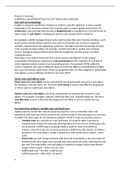Finance 2 summary
CHAPTER 6: AN INTRODUCTION TO COST TERMS AND PURPOSES
Cost and cost terminology
A cost is a resource sacrificed or forgone to achieve a specific objective. A cost is usually
measured as the monetary amount that must be paid to acquire goods and services. An
actual cost is the cost that has incurred. A budgeted cost is a predicted or forecasted cost (a
future cost). A cost object is anything for which a cost measurement is desired.
For example, a BMW manager doesn’t only want to know the cost of various products, such
as the sports activity vehicle, but they also want to know the cost of services, projects,
activities, departments and supporting customers. Managers use their knowledge of these
costs to guide decisions about, for example, product innovation, quality and customer
service. Managers always need to know both the budgeted cost and actual cost when
making decisions.
How does a cost system determine the cost of various cost objects? In two stages:
accumulation followed by assignment. Cost accumulation is the collection of cost data in
some organized way by means of an accounting system. For example, BMW collects in
various categories the costs of different types of materials, different classifications of labor,
the costs incurred for supervision. Those accumulated costs are then assigned to designated
cost objects, such as different models of cars from BMW.
Direct costs and indirect costs
Direct costs of a cost object can be conveniently and economically traced to a cost object.
For example, material, labor, etc. The term cost tracing is used to describe the assignment
of direct costs to a particular cost object.
Indirect costs of a cost object cannot be conveniently or economically traced to a cost
object. For example, manager’s salaries, electricity bills, rent, property taxes etc. The term
cost allocation is used to describe the assignment of indirect costs to a particular cost
object.
Cost-behaviour patterns: variable costs and fixed costs
Costing systems record the costs of resources acquired, such as materials, labor and
equipment and track how those resources are used to produce and sell products or services.
Consider two basic types of cost-behaviour patterns found in many accounting systems.
o Variable costs are constant on a per-unit basis. If a product takes 5 pounds of
material each, it stays the same per unit regardless of if one, ten or a thousand units
are produced. If BMW buys a steering wheel at $600 for each of its BMW X6
vehicles, then the total cost of steering wheels is $600 times the number of vehicles
produced. The total dollars change in proportion with output (more output = more
cost).
o Fixed costs per unit change inversely with the level of production. As more units are
produced, the same fixed cost is spread over more and more units, reducing the cost
per unit. The total dollars are unchanged in relation to output (within the relevant
range). More output = lower cost per unit.
$3000 fixed cost / 10 units = $300 p/unit
$3000 fixed cost / 1000 units = $3 p/unit
1
, A cost driver is a variable, such as the level of activity or volume, that casually affects costs
over a given time spam. An activity is an event, task or unit of work with a specified purpose
– for example, designing products, setting up machines, or testing products. For example, if
product-design costs change with the number of parts in a product, the number of parts is a
cost driver of product-design costs.
Relevant range
The relevant range is the band or range of normal activity level or volume in which there is a
specific relationship between the level of activity or volume and the cost in question. For
example, a fixed cost is fixed only in relation to a given wide range of total activity or volume
(at which the company is expected to operate) and only for a given time span (usually a
particular budget period).
Total costs and unit costs
A unit cost, also called an average cost, is calculated by dividing the total cost by the related
number of units produced. Although unit costs are regularly used in financial reports and for
making product mix and pricing decisions, managers should think in terms of total costs
rather than unit costs for many decisions.
Types of firms
o Manufacturing-sector companies purchase materials and components and convert
them into various finished goods.
o Merchandising-sector companies purchase and then sell tangible product without
changing their basic form.
o Service-sector companies provide services (intangible products) – for example legal
advice or audits.
Types of inventory
Manufacturing-sector companies typically have one or more of the following types of
inventory:
o Direct materials are resources in stock and available for use
o Work-in-process (WIP) are goods that are not yet completed.
o Finished goods are goods completed but not yet sold
2






